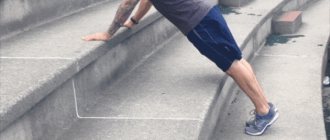Running for beginners is the best way to exercise, because it is one of the simplest and most useful sports activities that improves health and has a beneficial effect on the human body. As with any sport, the hardest part is getting started.
In this material we will talk about how best a beginner can prepare and adapt to running, share information about the best places for jogging, and talk about what clothes and shoes are best to wear. We will also pay attention to training programs, talk about the importance of warming up and give some tips for running.
Set a goal and develop a training plan
Decide for what purpose you plan to run. Usually this is caused by something from the list below:
- Lose weight;
- Improve physical fitness;
- Prepare for running competitions;
- Train with the goal of running a specific distance (usually long distances or marathons);
- Take a break from routine worries;
- Join the running crowd and find new acquaintances.
Many things depend on the goal - drawing up a training plan, its intensity, frequency of training, etc.
An adequate training plan is important, it will help you distribute the load depending on your fitness level and prevent unnecessary injuries that can occur due to overuse of the body.
If you want to approach this matter thoroughly, contact a professional trainer for an individual plan. It will cost you money, but you will know for sure that you are doing it in accordance with the recommendations of an experienced person.
You can find a group and train together - a good way to make new acquaintances and have a good time. However, the average level of the group may be either significantly higher or significantly lower than yours - find out about this before starting classes.
The easiest option for creating a plan is to use running apps that provide various training programs, as well as the ability to create your own.
Training 5x1000 meters - the optimal method of preparing for the race
Any distance will require the ability to calculate strength, take into account the fact of increasing fatigue and the need to maintain a given pace for a long time. Don't forget about the finishing spurt - accelerating to the maximum possible speed approximately 500 m before the finish. Experienced athletes do not recommend saving too much energy over the entire distance. Even at a slow pace, fatigue will still come, and there simply won’t be enough strength for the finishing push. However, the 5 km segment can be covered without acceleration at a steady pace.
Training programs designed for 6-8 weeks of classes will help you reach a certain level. The main goals of running work are to build speed endurance, let the body get used to the distance, prepare for intense loads, develop speed qualities and physical strength.
The 5 X 1000 meters system is considered the most effective for developing a sense of rhythm and the habit of intense exercise. The entire distance is divided into equal sections of 1000 m, which recommend running at an average pace: with a time of 4:25 (your pace will depend on your physical readiness). Between races, a short rest of 60-120 seconds is allowed for moderate recovery. There is no need to do any acceleration. Before training and immediately after, you should jog 2 km. This will allow you to warm up your muscles and ligaments, as well as cool down after intense running work.
In addition to physiology - increasing endurance and power, increasing the athlete's aerobic capacity under load and strengthening muscles and the musculoskeletal system - the training process also develops psychological stability. Moderate, monotonous exercise will prepare you for a long distance. You will quickly develop a feeling of benefit from your efforts. In addition, gradual adaptation to the distance is much better than overload for unprepared athletes who are forced to simply abandon the training process.
This type of training should be complemented by approaches that develop speed endurance and power performance against a background of fatigue. For this reason, in a weekly schedule, it is recommended to include 5 X 1000 meter races a maximum of 1 time with rest or light intensity loads the next day.
Clothes and shoes for beginners to run
If you think superficially, it seems that nothing is required for running except comfortable shoes - this is not so. Clothing is also extremely important. Here are some tips for choosing running gear:
- Pay attention to the material from which the clothes are made. For running, special models have been created from synthetic fabrics that wick away moisture and help it evaporate quickly. When purchasing, focus on well-known brands that have proven themselves in the market. Familiarize yourself with the composition of the fabric and its characteristics - they are described in detail on the label;
- Comfort - clothes should be loose, and shoes should not rub and provide complete comfort in movement;
- Take care of functionality: pockets, fasteners, inserts that reflect light will be useful in the dark;
- Comfort accessories - headband, gloves, phone holder, water bag - all of these things can make your run easier and more enjoyable.
Warm-up
Any workout should begin with a warm-up, this will reduce the likelihood of various injuries and prepare the body for stress. There are several warm-up options before running:
- Exercises for general physical training are performed for 7-10 minutes;
- Walk, jog, or lightly jog for 15 minutes;
- Warm up the joints - circular movements in the knees, shoulders, neck, ankle, etc.;
- Self-massage – improves blood circulation in the muscles.
Do not forget to warm up before each lesson, this cannot be neglected. Beginners often forget about warming up, which sometimes leads to muscle and other types of injuries.
Interval running training for beginners
Short intervals
These are sprint intervals ranging from 100m (a quarter lap of a standard treadmill, i.e. one straight section) to 400m. The purpose of short intervals is to increase speed, strength and ability to maintain them. These intervals are good for increasing running speed, but are also effective for marathon runners because they make it easier to maintain your current marathon pace.
The recovery periods between short intervals should be long enough - about three times the work intervals - so that you can maintain a constant level of speed. If you don't have enough recovery time, your speed will decrease from one interval to the next, and the workout will become a test of endurance rather than an improvement in speed and strength. The recovery period can be active (jogging) or passive (walking or standing).
- 6 x 100 m;
- 6 x 200 m;
- 6 x 300 m.
Average intervals
Intervals of 600–1200 m are average distances. They can be used to improve aerobic performance, lactate threshold and endurance, which help you run at higher speeds for longer periods of time. It is unrealistic to run such a distance at the maximum pace, so try to move at about 70% of the maximum speed. It's not an exact science, but there is a general rule to follow; if you feel yourself starting to slow down, pick up the pace a little to get out of your comfort zone. The idea is to run through each interval as quickly as possible, but it's important to finish them rather than push yourself to the point of exhaustion. Wait until you are completely out of breath before starting the next interval.
- 5 x 600 m;
- 4 x 800 m;
- 3 x 1000 m.
Long Intervals
Long intervals vary from 1600 to 3000 m. During this time it is impossible to maintain a constant maximum speed, and 70% of it will also be difficult to maintain. Instead, just make sure you keep putting in the effort and don't start jogging.
Because of their duration, it will only take a few long interval workouts to feel the benefits. They are especially good for improving overall endurance and lactate threshold (the time it takes before muscles actually start to hurt). The rest periods between intervals should be as long as it takes for you to fully catch your breath and for your legs (or any other muscles) to stop hurting.
- 4 x 1600 m;
- 3 x 2000 m;
- 3 x 2400 m.
What is the best time to run?
They say it's better to run in the morning. It depends on your biorhythms and the state of your body at a given time. For some it is really convenient to get up at 6 am and start their day with an invigorating run in the fresh air, but for others it is unbearably difficult to do this.
Run at the most comfortable time. Avoid the scorching sun and do not run at midday - you will get sunstroke or overheat. Consider the weather conditions and find the optimal time for training. Accustom your body to this time and it will become much easier to exercise.
8×600 meters training
Set 8 x 600 is also the main goal of developing endurance and getting used to the distance. It is recommended to run the segments at 90% of the possible speed of that at a distance of 5 km. In this case, the time required for each set is 2 minutes 50 seconds (for a trained amateur). You can rest for no more than 90-45 seconds between 600-meter runs. To get the effect, this type is included in the program 6-8 weeks before the competition.
Where is the best place to run?
Running sessions typically take place in three locations: outdoors, on a treadmill, and in sports arenas or indoor stadiums. The best option would be to jog outdoors, however, when the weather does not permit, you can go to the gym or, if you have a treadmill, do a workout at home. Remember the nuances that distinguish running on the street from exercising on a treadmill:
- The load on a treadmill is different from running outside - there is no headwind and running becomes easier. For this there is an angle of inclination that can be adjusted;
- The technique of running on a treadmill differs from regular running on the street due to the need to constantly maintain a slight angle of inclination of the body forward;
Let's look at the main pros and cons of running on a machine and regular running training on the street:
Treadmill, pros:
- You can practice at any time, regardless of weather conditions;
- You can control your running pace;
- At the same time, you can watch a video by placing your phone or tablet in front of you;
- Smooth surface, unlike asphalt on the street;
Minuses:
- You won’t be able to breathe fresh air like outside;
- Feet do not get used to the hard street surface;
- You can’t run in a group, with friends;
- Boring and monotonous.
Read our material on the topic “The best treadmills for home.”
Running outside, advantages:
- Jogging occurs in natural conditions;
- Fresh air;
- The sun gives the body vitamin D;
- You regulate the pace yourself and will soon learn to feel the speed that is comfortable for you;
- You can combine jogging with business, for example, running somewhere to run errands;
Minuses:
- Training depends on the weather;
- Uneven asphalt or other surfaces can cause injury;
- Cars, animals, people and other dangers;
Thus, the best option would be to combine indoor and outdoor running. In case of good weather, the choice is obvious; in case of bad weather, a gym or a treadmill at home.
Another important nuance is the running surface. In urban areas:
- Asphalt is the most popular surface in the city. Hard, with bumps and depressions in places. You need to be careful and watch your step. It is also better to use special running insoles that will soften the contact of the sole with the surface;
- Concrete is a hard surface and places excessive stress on the feet. Plus, it’s traumatic;
- Tiles are worse than asphalt in terms of hardness and unevenness, you can accidentally trip and get injured;
- Artificial turf in an arena or stadium is the best option for running. The legs receive less load and do not get tired as much.
Outside the city:
- The ground is dirty and can be slippery in the rain, but in dry weather it is quite soft and easy on the joints;
- Sand is viscous and uncomfortable to run, but sometimes such surfaces should be used in training sessions to develop stabilizer muscles and strengthen the body;
- Snow is inconvenient, especially if the depth is deep. In general, you can run on trampled snow, but there is a risk of tripping and damaging your ankle;
Interval training Fartlek
Great for adding variety to your regular runs
Fartlek means "speed game" in Swedish. Unlike other forms of interval training, which have a predetermined time frame, in Fartlek training you run at different intensities for different periods of time. This forces the body to guess what will happen next, forcing the heart, lungs and muscles to work harder and leading to improved fitness.
Warm up for 5 minutes... and then act according to the circumstances. If you spot a lamppost, tree or another runner in the distance ahead, run at high speed until you reach them, then slow down to recover. Then find another landmark and run towards it quickly. The beauty of Fartlek workouts is that you can make them as difficult or easy as you like. This makes the usual running pattern a little more useful.
How long should beginners run?
Decide on your training days; to begin with, three days a week will be enough. One day of training, one day of rest is an excellent schedule that will allow the body to fully recover after exercise.
Below are two running workout plans for beginners.
Running pattern No. 1:
Running pattern No. 2:
- Week 1: 3 minutes of running, 2 minutes of walking - 6 series, for a total of 30 minutes.
- Week 2: 4 minutes of running, 2 minutes of walking - 5 series, for a total of 30 minutes.
- Week 3: 5 minutes of running, 2 minutes of walking - 4-5 series, for a total of about 28-35 minutes.
- Week 4: 5 minutes of running, 1 minute of walking - 5 series, for a total of 30 minutes.
- Week 5: 30 minutes of running.
- Week 6: 35 minutes of running.
- Week 7: 40 minutes of running.
- Week 8: 45 minutes of running.
How to start running correctly for beginners
It is important to choose the right amount, duration and intensity of your running training.
- Quantity – no more than 3 times a week.
You don't need to run every day. Even professional athletes don't do this. For beginners, 2-3 times a week is enough. Of course, not on consecutive days.
- Duration – run from 20 minutes to 1 hour.
Some experts recommend doing cardio for at least 30 minutes for the workout to have any effect. Others write that 10-15 minutes is enough.
There is an opinion about 20 minutes, and since it is just average, we recommend it. This time includes transitions to a step if you need it to lower your heart rate.
But gradually increase your training time to 40-60 minutes. Gradually means adding 2-5 minutes to the next workout. When you reach 1 hour (or less, if it’s hard), you can start jogging again from 20 minutes, but at a slightly faster pace.
If you want to lose weight, the duration of the workout is even more important. To do this, it is better to run slowly for 1 hour than to run relatively quickly for 20 minutes. And the muscles do not immediately begin to burn while running.
- The intensity, that is, the speed, is comfortable for you.
So that it is not easy, but also not difficult. The following recommendation is often given: it should be comfortable to speak when running. To put it hard, you took the pace too fast for yourself. That is, ideally, you should try to run on the edge, when you are still comfortable, but if you accelerate a little, you are no longer comfortable.
We wrote above about the pulse - 110-130 beats per minute.
If it's hard, don't hesitate to take a step. For some beginners, such transitions are more likely the norm if the pulse leaves the desired pulse zone. Or initially you need to run slower.
Slow down if you feel short of breath. Don’t allow yourself to feel like you have a pain in your side or want to fall to the ground. It won't do any good.
When running at an inappropriate pace and a heart rate higher than what is suitable for you, the cardiovascular system cannot cope with such a load, which carries its own risks for the body. Such prolonged exercise at a high heart rate no longer brings benefit, but harm. Especially for unprepared beginners.
Therefore, it is important to run at a low heart rate for the first time. This will provide the necessary adaptation for the heart, optimizing the work of the myocardium. Stroke volume will increase and heart rate will decrease.
The essence of the benefits and training effect of running is that you build on your current capabilities - and gradually, smoothly and constantly increase them.
The most important rule is to increase the load gradually.
It can be helpful to start keeping a workout diary. Note the date, distance, pace.
You can join group training. There are not only paid groups, but also free or paid ones. At a minimum, communicating with like-minded people will add motivation to beginners.
But there is not much attention to each student there. Therefore, if you want to learn the correct running technique, it is better to take several individual training sessions from a good trainer. He will explain the basics, what to pay attention to, and create a training program. And you will continue to study on your own. In the end it will be better quality and cheaper than running in a group.
On Saturdays, free parkrun races are held in many parks in Moscow and St. Petersburg.
As a runner grows in experience, the number, duration and intensity of workouts increases. But it’s still better to do no more than 4 workouts per week.
Ways to diversify your loads:
- Do interval training.
This is when you alternate between running and resting. You can do both sprints and jogs for several minutes. Rest should be no less than running time.
- Use ascents and descents.
Well suited for uniform load on all muscle groups.
- Use weights (belt, backpack, or on wrists and legs).
You should also definitely add strength training. This will allow you to run better and more efficiently, and will also reduce the risk of running injuries. Not to mention other positive effects not related to running.
In general, it is important to develop all qualities: not only endurance and speed, but also strength, strength endurance, agility and flexibility.
Tips for running
- Start with regular walking if running is difficult. So you will gradually get used to it and switch to an easy and then moderate running pace;
- Try alternating running and walking workouts to allow your body to adapt to the stress. 3 minutes of running, 2 minutes of walking and so on;
- Classes should be regular: choose several days a week and practice constantly, without missing workouts. Gradually increase the time and intensity of your running;
- A good warm-up is the key to avoiding injuries. Don’t forget to warm up before each workout, warm up your muscles well and prepare your body for the stress;
- After training, do stretching and recovery exercises, this will help your muscles bear the load more easily and not become clogged.
Read our tips on “How to breathe properly while running.”
Exercises with elastic bands for arms and shoulders
Raising arms overhead
» Secure the elastic band around your wrists. "IP: bend your elbows, keep your palms straight in front of you. » Spread your arms out to the sides. » At the maximum point of resistance, raise your arms above your head.
Biceps curl
» Wrap your fingers around the tape. » Place one hand on the opposite thigh and hold the loop. » Bend your other arm at the elbow. » Repeat 15-30 times on each side.
Raising your arms in front of you
» Secure the elastic band to your knuckles. » Extend your arms in front of you at shoulder level. »Pull one hand down and the other up. » Hold at the point of maximum resistance for 1-5 seconds.
Raising arms to the sides
» Secure the elastic band to your elbows. "IP: standing, extend your arms in front of you. » Spread your arms out to the sides.
Abduction of arms down
» Secure the elastic band around your wrists. » Bend one arm at the elbow and rest it on the opposite shoulder. » Bend your other arm at the elbow as well. » Extend your lower arm, trying to get your wrist as low as possible.
Raising arms to the sides
» Secure the elastic band around your wrists. » IP: standing, bend your elbows, but do not press them to your body. » Raise one arm to shoulder level. » Return to IP and repeat on the other side.
Pull down
» Secure the elastic band to your palms. "IP: standing, raise your arms up. » Bend one arm at the elbow. » Return to IP and repeat on the other side.
"Walking Board"
» Secure the elastic band around your wrists. » IP: support on the palms and toes. Keep your back straight. » Move your palm forward, pulling the elastic band, and then the other. Do not bend your elbow joint. » Return to IP.
Raising your arms in front of you
» Grasp the ends of the tape with your hands, pulling it behind your back. » As you inhale, spread your arms to the sides. » At the point of maximum tension, hold for 1-5 seconds.
Standing raises
» Secure the tape under your feet. » Grasp the ends of the tape with your hands. » As you inhale, raise your arms to shoulder level. » At the point of maximum resistance, hold for 1-5 seconds.
Running mistakes
Running only seems simple, in fact, you even need to run correctly and avoid some of the mistakes described below.
Mistakes when running:
- Excessive running speed or too long training, as a result: injuries, clogged muscles, depressed psychological state;
- The wrong choice of clothing and shoes for running also leads to injuries, blisters and other inconveniences during training;
- During intense training, you need to drink water; dehydration is an unpleasant thing;
- Running through pain leads to worse consequences and injuries;
- Dress inappropriately for the weather - you can get sick or, conversely, overheat;
- Daily training is a mistake. It is necessary to give the body proper rest.
Lessons for beginners
How can a beginner athlete effectively lose weight in fitness? Beginners should get a set of three rubber bands. Start training with minimal load, and then increase it every couple of weeks. The first approach trains the muscles of the legs and buttocks. To do this, the expander is placed slightly above the ankle, the legs are spread until tension appears in the muscles and, without moving them, they begin to walk. It is allowed to slightly bend your knees and tilt your body forward. Take 7 lateral steps in both one and the other direction, repeating the procedure 14 times. After this, the elastic band is left below the shin, the legs do not move. Squeeze your buttocks tightly and do 10 squats, then 5 squats simultaneously with springy movements performed in the lower position.
Attention! Before starting training, a novice athlete must undergo a medical examination and set possible restrictions on physical activity. During the second approach, the muscles of the buttocks and back of the thigh are trained.
The expander is put on the ankles, the lesson is carried out while lying on the floor. Initially, they turn over onto their stomach, placing their chin on their folded arms. The legs are spread in different directions and one by one they begin to lift up, repeating the lift 14 times for each leg. Then they turn over onto their back, the expander is moved to the lower part of the thigh. The legs are bent at the knees and spread apart, while the elastic band should be taut. The pelvis is raised and held for a couple of seconds in this position, straining the gluteal muscles as much as possible. The exercise is repeated 20 times
During the second approach, the muscles of the buttocks and back of the thigh are trained. The expander is put on the ankles, the lesson is carried out while lying on the floor. Initially, they turn over onto their stomach, placing their chin on their folded arms. The legs are spread in different directions and one by one they begin to lift up, repeating the lift 14 times for each leg. Then they turn over onto their back, the expander is moved to the lower part of the thigh. The legs are bent at the knees and spread apart, while the elastic band should be taut. The pelvis is raised and held for a couple of seconds in this position, straining the gluteal muscles as much as possible. The exercise is repeated 20 times.
The third approach focuses on training the gluteal muscles and lower thighs. The expander should be placed on the hips and taken 7 steps in one and the other direction, repeating the exercise 14 times. The expander should be in a tense position, the muscles tense. After this, move it to the lower part of the thigh, spread and bend your legs halfway. Squat in this position 14 times, then do 5 squats with three springs. When moving to the top position, the buttocks are squeezed tightly.
Exercises with elastic bands are effective if done regularly.
The first month of training will be the most difficult, since the body has not yet adapted, and the body has not had time to get used to the new routine. If a week of exercise does not cause any sensations and does not bring results, you may need to change the technique and select a new set of exercises. When a person has health problems, he will definitely need to conduct his first training sessions under the supervision of a specialist. Any complications or health problems lead to immediate cessation of classes. Otherwise, further activities may lead to unpredictable negative consequences. People suffering from cardiovascular disorders and chronic diseases are at particular risk.
Nowadays such sports as fitness are gaining more and more popularity. How quickly can you lose weight without starving or weakening the female body? Exercises using a fitness band help women not only tighten their body and make it more attractive, but also lose excess weight. The decisive factor here is not the applied load from the expander, but the correctly selected and developed training system and choice of exercises. It is not necessary to visit a gym or hire an expensive trainer to conduct classes. Everything can be easily done at home in your free time, then enjoy the results achieved.
Where to run if the weather is bad outside
If it is dark, damp and unpleasant outside, and even more so there is ice and snow, you need to find a convenient place for training. The options are as follows:
- Treadmill at home;
- Treadmill in the fitness room;
- Running in place;
- Running in an indoor arena or stadium;
The last option will be the best - the most realistic conditions and a foot-friendly coating will allow you to conduct an effective and high-quality training. Also, the ventilation of such rooms is much higher, breathing will be more comfortable and freer. There is also the opportunity to train in a group or with a personal trainer - this is also a plus for running in an arena.
How many times a week should you exercise
Exercises for weight loss with a rubber band bring positive results only if the training schedule is correctly drawn up.
Attention! You cannot conduct daily workouts using fitness bands; the body must have time to rest. Beginners often make the mistake of training too often and too intensely.
As a result, the muscles do not have time to fully recover. Experienced trainers advise taking breaks and on some days completely eliminating physical activity. Otherwise, the result will be minimal. To lose weight, it is enough to exercise 3, maximum 4 times a week
Beginners often make the mistake of training too often and too intensely. As a result, the muscles do not have time to fully recover. Experienced trainers advise taking breaks and on some days completely eliminating physical activity. Otherwise, the result will be minimal. To lose weight, it is enough to exercise 3, maximum 4 times a week.
It will not be possible to achieve positive results by concentrating the load on a specific muscle group. For sustainable weight loss, you will need regular home workouts lasting 40 minutes with anaerobic exercise.
Attention! Each workout should be structured in such a way that a person uses at least 23% of their total muscle mass











